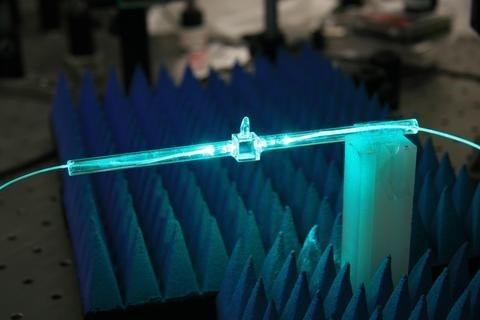Summary
NIST’s Communications Technology Lab is developing a new paradigm for RF field sensing and measurements based on the atom. The Rydberg Atom-based RF Field Probes team is using highly excited alkali atoms to detect and measure electric fields from DC to daylight (from Hz to THz) with high sensitivity and fidelity. Due to the standard behavior of these atoms, this independent RF measurement method provides direct traceability to SI-defined constants.
Description

The first fiber-coupled vapor cell for E-field measurements using Rydberg atoms.
Calibrated radio frequency (RF) electric field probes and antennas are currently limited by a complex, indirect traceability path and require a complex calibration – which presents a chicken-and-egg dilemma. Probes must be calibrated by placing them in a known electric field, while a precisely known electric field is only realized using calibrated probes. Borrowing a technique from atomic spectroscopy, electromagnetically-induced transparency (EIT), we can use atoms as a noninvasive field probe for directly SI-traceable, self-calibrated RF electric field measurements over a huge range frequency.
Current Project Goals
The Rydberg atom-based sensing technique has shown promise for many applications beyond RF field probe calibrations. We are currently exploring:
- Fundamental RF Field Metrology – Atom-based microwave field measurements are independent of the traditional calibration method. We are exploring the extent to which Rydberg atom-based field probes can improve field probe calibrations and push the limits of RF field metrology.
- RF Camera – Formed from an array of Rydberg sensors, the RF camera will be able to measure the magnitude and phase of an RF field at multiple points in a low-invasive package that reduces distortion of the field.
- Communications Reception – the Rydberg atoms can act as electrically small antennas and detect the modulation of a carrier wave. They can detect and demodulate AM, FM, and phase modulation over a broad range of carrier frequencies – making them a promising platform for advanced communication receivers.
- Blackbody Radiation Characterization – Highly excited Rydberg atoms are very sensitive to external fields and can sense changes in thermal radiation. We have a project to explore the limit of using Rydberg spectroscopy to measure and calibrate blackbody radiation.
- DC/AC Voltage Standards – We are exploring the application of atom-based field measurements to DC – kHz voltage measurements to provide less expensive self-calibrated, SI-traceable voltage standards.
- RF Power Metrology – We have two methods for advanced RF power metrology, using both Rydberg atom measurements as well as photon pressure. These two methods can span a much larger dynamic range of traceable power measurements, from nW – kW, than traditional calorimeter-based measurements.
“A ‘real-time’ guitar recording using Rydberg atoms and electromagnetically induced transparency: Quantum physics meets music,” AIP Advances 9, 065110 (2019). https://doi.org/10.1063/1.5099036
“Scientists develop innovative, atomic resonance-based method to measure electric fields,” Phys.org (2017). https://phys.org/news/2017-06-scientists-atomic-resonance-based-method-…
“Weak electric-field detection with sub-1 Hz resolution at radio frequencies using a Rydberg atom-based mixer,” AIP Advances 9, 045030 (2019). https://doi.org/10.1063/1.5095633
“Using radiation pressure to develop a radio-frequency power measurement technique traceable to the redefined SI,” Appl. Phys. Lett. 113, 164102 (2018) https://doi.org/10.1063/1.5052258
“Fiber-coupled vapor cell for a portable Rydberg atom-based radio frequency electric field sensor,” Applied Optics, vol. 57, no. 22, pp. 6456-6460 (2018). https://doi.org/10.1364/AO.57.006456
“Measurement Challenges for 5G and Beyond: An Update from the National Institute of Standards and Technology,” IEEE Microwave Magazine, vol. 18, no. 5, pp. 41-56, July-Aug. (2017). https://doi.org/10.1109/MMM.2017.2690882
“A New Quantum-Based Power Standard: Using Rydberg Atoms for a SI-Traceable Radio-Frequency Power Measurement Technique in Rectangular Waveguides,” Appl. Phys. Lett. 94101, 113 (2018). https://doi.org/10.1063/1.5045212

